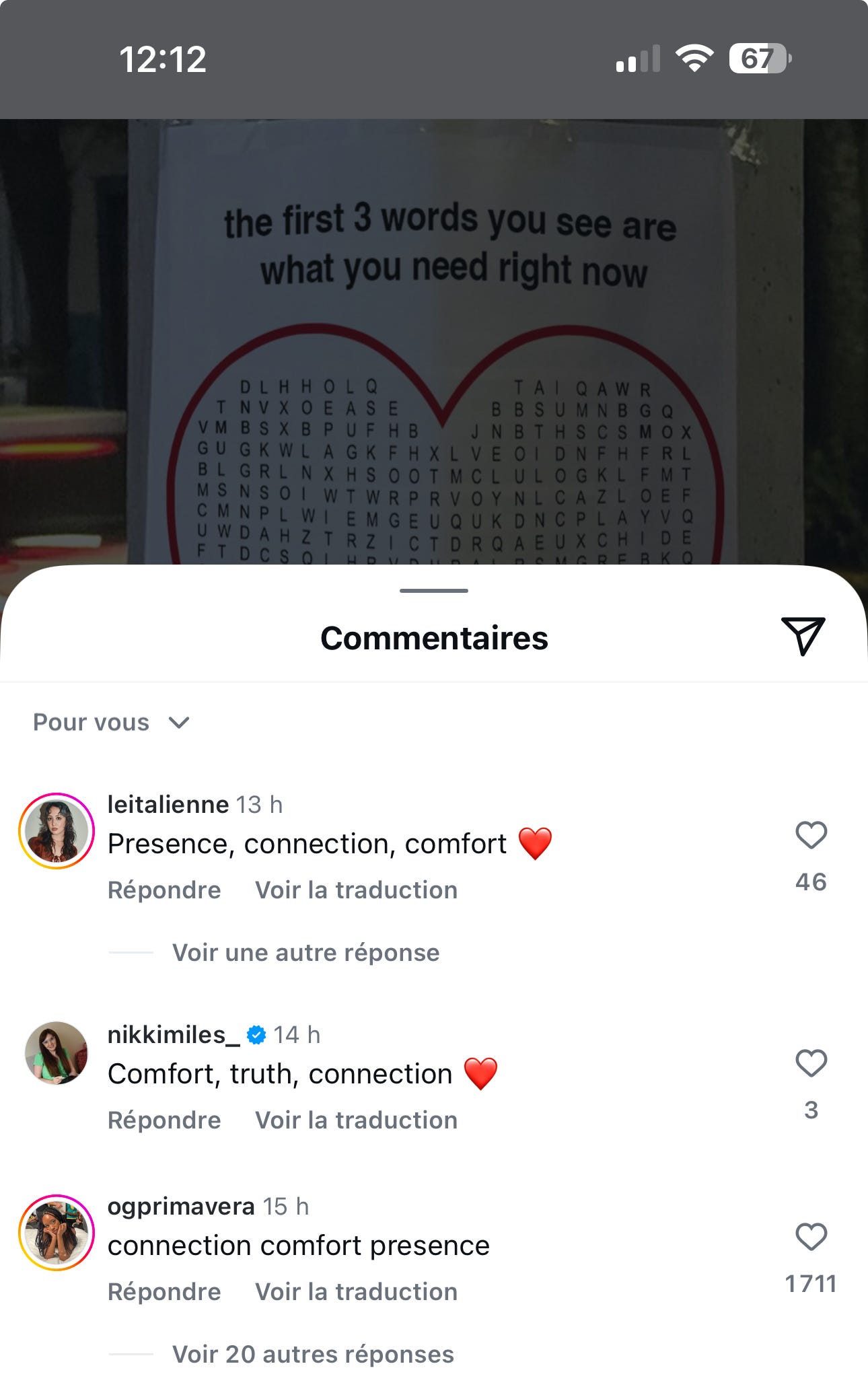The Art of Commenting on Social Media
A comment is far more than a quiet extension of a post — it reveals the nature of a community and its values. It has become media within media.
Tuesday Night on Earth. Feel free to share this letter… and comment.
In the collective imagination, a comment is secondary: it extends, nuances, or validates content. Yet in today’s digital ecosystem, it’s become much more than that. A comment is media within media, a social signal, a space of fiction and friction, and a strategic tool in the attention economy. Let’s unpack.
The Design of the Comment: Shaped by UX
On platforms like TikTok or YouTube, comments are often placed on equal footing with the content itself. They’re part of the cues that shape the user experience, just like view counts or likes. A comment frames the tone of a post before we’ve even clicked the video or image.
A core element in shaping how a post is perceived, comments can also spin off mirror narratives or parallel storytelling. They enrich context, twist meanings, and tell stories within the story. Brands have picked up on this, weaving their narratives into comment threads — sometimes subtly, sometimes not.
Ryanair, for instance, leans into a kind of absurd corporate trolling in its comments.
In this light, the post becomes a pretext: the real collective work happens below, in the threads.
Some accounts have developed a true “comment culture,” where users dive in, get inspired, and reply to each other — often more than they watch the original content. The voting function highlights which reactions generate the most traction, turning comment sections into open-air democratic arenas.
Commenting: Between Community Life and Social Performance
A comment is also a tool of belonging. The “first” comment — a well-known game among fan communities — is a way to signal loyalty and presence.
Behind every word, every emoji, lies a grammar of community. In music or artist fandoms, symbols create visual in-jokes. Justice’s cross, for instance, is instantly recognizable and used as an emoji of recognition.
Commenting also works as social signaling. Public figures and influencers carefully choose where they interact — not just to show up in spaces related to their world, but to feed their own storytelling. A fashion figure commenting on more edgy or grungy brand content may do so out of genuine interest, but also to send a powerful social signal.
Comment Surfing: Discovery by Detour
The comment has also become a powerful gateway to content — sometimes more effective than algorithmic recommendations. “Comment surfing” refers to the practice of following a thread of comments from one video to another, from one account to the next, like following breadcrumbs through a digital forest. It’s not the post that pulls us in, but the comment that sparks curiosity, nudging us to seek out “the context.”
On TikTok, it’s common to see comments like “anyone got the link to the full version?” or “it hits better if you watch part 2.” These trigger side quests — content hunts activated by the community. On YouTube, film clips or viral debates often get rediscovered through comments that resurface on Twitter or Reddit. The comment becomes a rallying flag — a fragment of a phrase that pulls us toward content we’d never have searched for ourselves. On Instagram or X (formerly Twitter), screenshots of particularly funny, absurd, or touching comments circulate as standalone memes. The comment is no longer a reaction — it’s a piece of cultural transmission. This logic reshapes how we roam the platforms: no longer post-to-post, but comment-to-comment, through an oblique, more social kind of navigation.
The Dark Side: Toxicity and Covert Propaganda
But beware — comments aren’t always cute and wholesome. Far-right (and far-left) groups often hijack seemingly trivial posts to inject dog whistles, spam threads with cause-related emojis (like Pepe the Frog), or twist the tone of the conversation. Because comments create a side-channel of discussion, they turn the anecdotal into a vector for large-scale cultural propaganda. They help set a “vibe” that gradually shifts values. Comment sections can quickly become minefields, where meaning flips based on a community’s hidden codes.
The Comment: A Social Essence to Be Managed
Disabling comments is like cutting off the social oxygen of a post. In a recent Harvard Business Review study (August 2024), researchers showed that when celebrities turn off their comments, it creates more frustration than protection. Silence fuels perceptions of inauthenticity, isolation — even contempt. Keyboard warriors get angrier, feeding a cycle of tension.
The comment has become the true space for social evaluation. It transforms the act of posting into a call for conversation, a space for resonance — sometimes even collective fiction. As some platforms begin to value fine-grained interaction over raw posting, commenting might just be the most powerful act of digital presence.
The Stat of the Week: 63%
According to Meta, 63% of Gen Z say they spend significant time organizing their Instagram (and Facebook) feeds to see more relevant content, feel more in control, and… save time. A way to fight back against algofluence?
Amazing links
The art of prompting in retro gaming mode (Google Gemini)
The Piper Sandler Taking Stock With Teens® survey (Piper Sandler)
A New Social Media App Punishes Users for Rage-Baiting (Wired)
Have a great week! This newsletter is written with love, passion, and (French) coffee. Feel free to share this newsletter, like, comment, or keep sending me emails: these notifications are a joy.
My book “Alive In Social Media” is available on Amazon.











🕵️♀️
Very interesting! I’m about to teach social media content analysis next week so I may well quote and refer to your piece - I hope this is acceptable! I’ll ensure I make proper reference in my course slides! 🙏